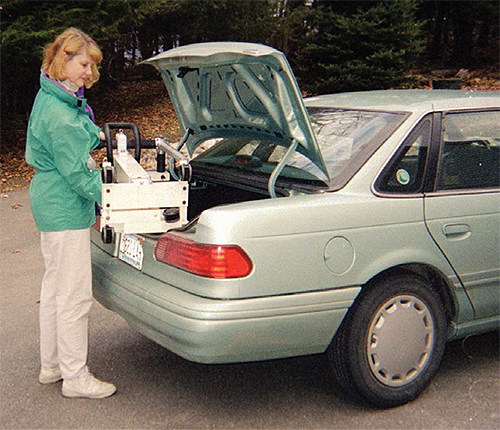Everyday mobility can be a problem for those who are sick and bedridden. Getting out of a wheelchair, bed, car seat, or chair can be difficult, especially without assistance. Until recently, people struggling with standing and walking did not have many lightweight and portable devices to help them become more mobile. Rather, typical handicap lifts are large, heavy, and not very portable. They tend to be overhead boom lifts that are hard to maneuver in a car since they often lack the necessary clearance.

Alex Brandorff designed the Portable Transfer Aid, a lift device for transferring handicapped people from one place to another.

Alex Brandorff, a research and development engineer, became aware of this problem when a friend who was struggling with this issue approached him to see if Brandorff would design a product to help. Brandorff created a unique patient transport device for transferring individuals from one place to another. The Portable Transfer Aid (PTA) is a lift that offers added mobility, independence, and improved quality of life for the handicapped while protecting health care providers from muscle strain and injury. The PTA does the work of raising and lowering the patient. Little effort is required on the part of an attendant.
The PTA base may be spread to fit around the outside of a standard wheelchair for maximum stability, or the legs may be placed forward for maneuvering in tight spaces or through standard doorways. The lift folds up neatly into a compact size for storage or travel. The legs can be placed either straight ahead or spread apart for transfers, or folded for storage. When folded, the device fits into the trunk of a car without disassembly and can be unfolded for use in seconds. With its legs and support arms folded, the lift can be rolled and stored in a closet or car trunk. It can also be separated into two pieces weighing less than 25 lb each when necessary.
The PTA has two different locking mechanisms. The first locks the legs in a folded position for storage or an open position for use. Two spring plungers mounted in the legs are used to lock them in an open position. Once the legs are unfolded and locked open, the other locking mechanism is used to lock the legs in one of two usage positions, with the legs pointing either straight ahead or spread apart. To spread the leg’s apart, a spreader bar is disengaged by pulling it inwards to release it from its locked position.
Brandorff used three igus iglide R plastic plain bearings in the latter mechanism. He chose to replace bronze bushings with these polymer alternatives to reduce cost and for convenience. “The bearings are cleaner because there is no residual oil.” Oil-impregnated sintered bronze bearings rely on capillary action to create a lubricating oil film. In contrast, the plastic plain bearings are dry running, contain a solid lubricant, and do not require additional lubrication or any maintenance. Dirt and dust particles do not stick to the surface.
The plastic plain bearings also contain a mixture of thermoplastic materials and embedded reinforced fibers. These fiber reinforced materials maintain the bearing’s strength and resistance to high forces and edge loads. This characteristic can be advantageous considering the lift’s weight limit of 300 lb. The maximum permissible surface pressure for iglide R bearings is 3,335 psi, although igus can supply plastic plain bearings that can withstand more. Both iglide T500 and Iglide Z standard materials can handle 21,750 psi.

The PTA was designed to use three igus iglide R plastic plain plastic bearings to reduce production costs and for convenience. The bearings replaced traditional bronze bushings.
Brandorff said that the iglide R’s softer material enables an easy press-fit. “There was some obstruction inserting the bronze bushings into the spring-plunger mechanism.”
The PTAs are designed to be used inside and outside. When transporting patients into a car, the device many encounter sunlight, snow, or rain. The bearings had to be impervious to these types of environmental conditions. The iglide R offers a low wear rate, long service life, and noise-free operation.
Plastic plain bearings have replaced bronze bearings in thousands of applications in a range of industries to date including medical and fitness devices, food processing and agricultural machinery, lawn mowers, marine equipment, pumps, valves, automotive, and wash-down applications.
Take-Along Lifts
www.TakeAlongLifts.com
igus
www.igus.com
Filed Under: Bearings, Medical-device manufacture, MECHANICAL POWER TRANSMISSION, Motion control • motor controls





Tell Us What You Think!